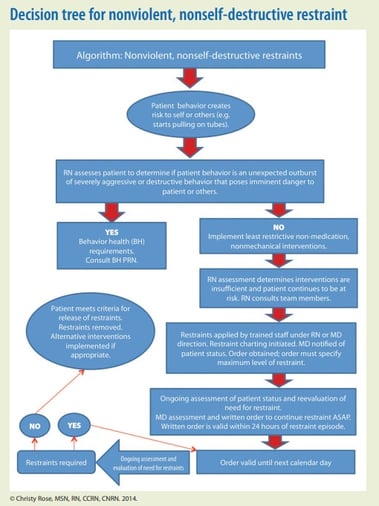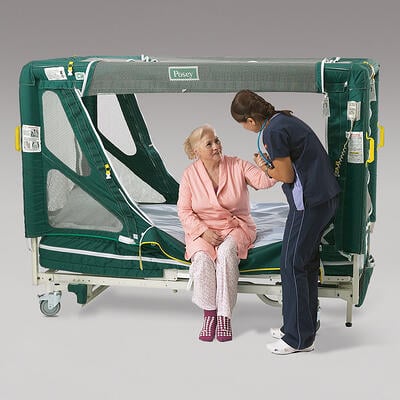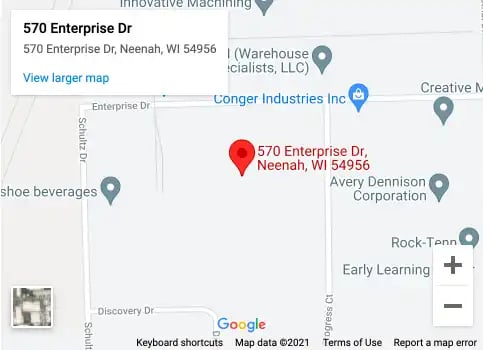 Less Restrictive Patient Restraints and Enclosure Beds
Less Restrictive Patient Restraints and Enclosure Beds
Nurses are entrusted with patient care and safety every day.
Medications, physical medical conditions, and/or diminished mental health can contribute to the sudden and often violent escalation of certain patient behaviors, including:1
- Hitting, kicking, or pushing
- Pulling out IV lines, tubes, or otherwise compromising medical equipment and devices needed for proper treatment
- Attempting to get out of a bed, chair, or hospital room when agitated, and in an unsafe, non-compliant manner
Any of these behaviors can put patients, staff, and others at considerable risk of harm. When faced with such situations, nurses are trained to intervene by first trying various de-escalation techniques. If these methods fail, however, then the use of less restrictive restraints or an enclosure bed may be appropriate.
Protection for Nonviolent, Non-Self-Destructive Patients
Emergencies involving sustained physical aggression threaten the safety of the patient, staff, and others. During these events, a nurse’s assessment, clinical judgment, and swift action are necessary.
In nonviolent, non-self-destructive situations, a decision tree may be followed to help one determine the application of medical restraints. The decision tree1 shown below was developed by Christy Rose, who recently spoke at a continuing education webinar hosted by TIDI Academy.
 As with aggressive patients, behavior and condition drive the type of restraint used.1 The specific options available to nurses depend on regulations issued by the Centers for Medicare & Medicaid Services (CMS) and The Joint Commission (TJC), as well as state laws and more discretionary hospital policies.
As with aggressive patients, behavior and condition drive the type of restraint used.1 The specific options available to nurses depend on regulations issued by the Centers for Medicare & Medicaid Services (CMS) and The Joint Commission (TJC), as well as state laws and more discretionary hospital policies.
Applying the least restrictive measure required to successfully manage patient safety for a given set of circumstances is always the right course of action. In many cases, nurses choose solutions such as limb holders, patient cuffs, roll belts, hospital mitts, and soft arm splints.
In some instances, an enclosure bed may be the best option for providing patient protection.
Enclosure Beds: Less Restrictive Hospital Bed Restraints
Enclosure beds create autonomous environments wherein at-risk patients are protected from unsafe bed exits. The structure of the Posey® Enclosure Bed, for example, is a mesh tent connected to a frame placed over a standard hospital bed, eliminating the need for more restrictive restraints like limb holders or vests.

Not all patients, however, are ideal candidates for this type of hospital bed restraint. Violent, combative, self-destructive, suicidal, or claustrophobic patients are generally excluded from enclosure bed consideration.2
Comprehensive behavioral assessment by an interdisciplinary hospital team is warranted before an enclosure bed is ordered and used as an intervention. Patients presenting high fall risk may qualify, provided they also exhibit at least one of the behaviors listed here:2
- Impulsiveness
- Agitation
- Inability or unwillingness to ask for assistance or respond to redirection
- Unsteady gait
- Wandering behaviors
Restraints Reminder
Although behavioral episodes of any degree or duration can carry significant risk, restraints should only be utilized as a last resort. We encourage you to visit TIDI Academy online for easy access to a variety of free continuing education webinars that cover topics such as de-escalation strategies and the appropriate use of restraints.
TIDI’s Posey-brand patient safety products have long prepared nurses to handle the unexpected with professionalism, discretion, and compassion. Learn more about how TIDI protects patients and supports caregivers, as well as the many ways in which we assist nurses. Contact the TIDI team today.
SOURCES
1 American Nurse Today (C. Rose), Choosing the right restraint, Volume 10, Number 1. Published online: January 13, 2015. Accessed online: January 2022. https://www.myamericannurse.com/choosing-restraints/
2 American Nurse Today (J. Harris), Enclosure bed: A protective and calming restraint. Volume 10, Number 1. Published online: January 13, 2015. Accessed online: January 2022. https://www.myamericannurse.com/use-enclosure-beds/







 Less Restrictive Patient Restraints and Enclosure Beds
Less Restrictive Patient Restraints and Enclosure Beds As with aggressive patients, behavior and condition drive the type of restraint used.1 The specific options available to nurses depend on regulations issued by the Centers for Medicare & Medicaid Services (CMS) and The Joint Commission (TJC), as well as state laws and more discretionary hospital policies.
As with aggressive patients, behavior and condition drive the type of restraint used.1 The specific options available to nurses depend on regulations issued by the Centers for Medicare & Medicaid Services (CMS) and The Joint Commission (TJC), as well as state laws and more discretionary hospital policies.
